|

Szabó Ágnes:
Te velem egy
Megnyitó: 1998. január 9-én pénteken este 19 órakor
volt
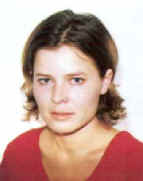 |
SZABÓ ÁGNES H-1015 Budapest, Batthány u.23.
Tel.: (36-1) 213 9709
1969-ben született Győrött
1987-91 Magyar Képzőművészeti Főiskola, Budapest (festő szak)
1990-94 Magyar Képzőművészeti Főiskola, Budapest (intermédia szak) |
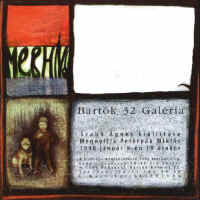 |
NŐ-ÖN
Nagy a csábítás Szabó Ágnes tükör-festményeit nézve, hogy
elidőzzünk a használt anyagok metaforikus vagy épp köznyelvi
jelentéslehetőségeinek elem-zésénél, a tükör által felmutatott enigmatikus
világkép szerkezetének működésénél, a műegyüttes egészének bemutatási,
nézési szokásokat tesztelő és átrendező, sérülékenysége miatt izgalmasan
zavaró karakterénél. Nagy a csábítás, sok a kiaknázható, szellemes vagy legalább
érdekes szövegkísérletre alkalmat adó segédtéma, mi által kikerülhető a
bemutatott művekkel, legalábbis azok megmunkálásával való szembenézés. Most az
következne, hogy ennek azért ellen kell állni. De nagy a csábítás, tehát akár
engedhetünk is egy picit. Mindenekelőtt érdemes megje-gyezni, hogy a tükör nem
képalkotó, a sugárzási irányt fordítja meg: tükörkép nincs, ez fából vaskarika,
a kör négy-szögesítése, vagy ablak a világra – csak nyelvjátékokban létezik.
Ezért vetít fényt is a tükör, s ha valamely ábra vagy hiba van rajta, akkor az mint
oldalfordított, "negatív" árnykép jelenik meg e fényidomban: ez sajátos, -
de nem a tükrözés geometriai értelmében vett – szimmetria. Valamirevaló
szimbólumszótárak az önismeret és hiúság; vanitas, a mágia, túlvilág, és a
pontos hasonlóság attribútumaként vagy eszközeként egyaránt említik. E század-ban
legalább két nagyhatású teória kulcsfogalma: a lacani tükör-stádiumra és a
marxista-leninista esztétika vissza-tükrözési "elméletére" utalok. (Nem is
olyan régen az esztéták szinte kórusban hangsúlyozták, hogy a
tükrözéselméletnél ők aktív tükrözésre gondolnak – érdemes ezzel összevetni
a lacan-követő Slavoj Zizek interpasszivitás terminu-sát.) A tükör szó
előfordulhat előkép, mintakép jelentésben, de lehet csillámkő, vagy példakép
illetve gon-dolkodási és cselekvési útmutató értelemben is valamely
szövegtükörben. (Sőt: "tükör - fehér folt a rőtvad farka alatt".) A
kiállításon a sorrendben első képcím: (Közhely)Szótár. Erről jut eszembe: A szem
a lélek tükre. A művészet a valóság tükre. Minek a tükre a képet néző szem
tükörképe?
A kép akkor kész, ha nézed – mondta nekem a megnyitó előtti napon Szabó Ágnes.
Vagyis a nézés aktusa – most nem épp Georges Bataille A szem története c. írása
értelmében – az a nélkülözhetetlen képelem, mely által a mű megtörténik. És a
kép nem akkor kép, ha nézed? - kérdezhettem volna vissza, de akkor ki kellene térni
arra a századunkban megjelent képtípusra, mely elé már az embert (a nézőt)
állítják oda, s nem fordítva, a képet a néző elé. S ez bármilyen érdekes,
végképp nem tartozik a tárgyhoz. Itt nem erről a fordított hierarchiáról van szó,
hanem a viszonyok szimmet-riájáról. A nézés fázisai: nem lát a szemétől –
megakad rajta a szeme – majd kiesik a szeme. A festmények a tükör üvegén kitakarnak
a nézőből, jelszerűen viselkednek, mint egy olyan tükörírás, ami a néző külseje
– saját maga számára hozzáférhetővé tett megjelenése – valamint képalkotó
tudata közötti síkon íródik. Az, hogyan nézem, befolyásolja: mit látok. Ezeket a
tükör-képeket nem lehet reprodukálni. A fotográfia – japán leírás szerint a
tükörkép hű árnyéka – kívül van az itt behatárolható képsíkok
megmutatásán. S ahogy nem reprodukálhatók, valójában nem is írhatók le; amit eddig
mondtam, tévedés: nézzék meg a kiállítást és beláthatják. Peternák Miklós |
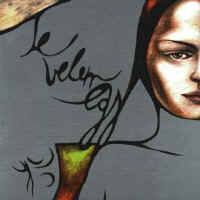 |
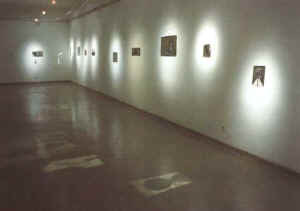 |
FEMALE - SELF
While looking at Ágnes Szabó's mirror-paintings one is greatly tempted to linger over
the analysis of potential metaphoric or colloquial meanings of the materials applied, the
functioning of the enigmatic world-concept's structure shown by the mirror, and the
overall character of the ensemble of the works which tests and rearranges the habits of
presenting and viewing and which, due to its vulnerability, is excitingly disturbing. The
temptation is great, there are lots of exploitable subsidiary themes giving opportunity to
witty or at least interesting text-experiments, through which facing the shown works or at
least their physical appearance is avoidable. Thence it would follow that this has to be
resisted. But the temptation is great, therefore we might as well succumb to it. |
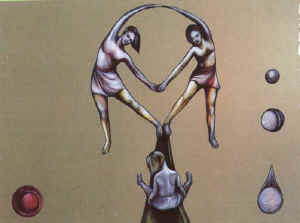 |
Above all, it is noteworthy that the mirror
does not create a picture, it reverses the direction of radiation: there is no reflection
in the mirror; this is absurdity, squaring the circle, or a window to the world - it only
exists in puns. That is why the mirror also projects light; and if there is an image or
fault on it, it appears as a 'negative' silhouette turned aside in this light-shape: it is
a peculiar symmetry, but not in the geometrical sense of reflection. Decent symbol
dictionaries equally mention it as the attribute or the means of self-knowledge, vanity;
vanitas, magic, afterworld and exact similarity. It is the key concept of at least two
influential theories in this century: I refer to the Lacan mirror-phase and the
Marxist-Leninist aesthetics' reflection "theory". (Not so long ago many
aesthetes emphasized that their reflection theory involved active reflection - it is
worthwhile to compare this with the Lacanist Slavoj Zizek's term of interpassivity.) |
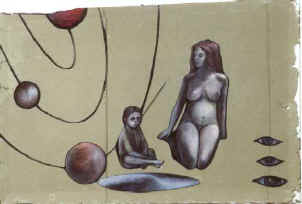 |
The word 'mirror' may also mean prototype, model, but it
may mean specular stone, or ideal, or in a certain context, guide for consideration and
action. (Moreover: "mirror - white spot under the tail of the fallow deer") The
first title of the exhibition is 'Dictionary (of common places)'. Which reminds me: the
eye is the mirror of the soul. Art is the mirror of reality. What is the reflection of the
reflection of the eye looking at the picture? The picture is ready when you are looking at
it - Ágnes Szabó told me yesterday. Hence, the act of looking - not only in the sense of
Geoges Bataille's writing 'The history of the eye' - is that indispensable element of the
picture by which the work comes into being.
And doesn't the picture become a picture by looking at it? - I might have asked, but then,
the type of picture that appeared in our century would have to be mentioned, in front of
which the person (the spectator) has been put to stand, and not the other way around; the
picture in front of the spectator. |
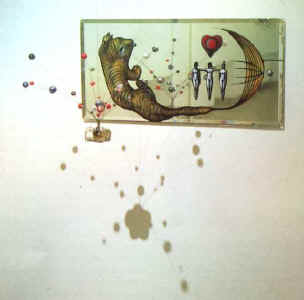 |
And however interesting this is, it is
totally beside the point.This is not about the inverse hierarchy here, but the symmetry of
the relations. The phases of looking: he doesn't see through his eyes - his eyes fasten on
it - his eyes nearly pop out.
The paintings block out parts of the spectator on the glass of the mirror, they behave as
signs, as a mirror-writing that is written onto the flat surface between the spectator's
look, his appearance wrought ithin reach for himself, and his picture-creating mind. My
way of looking at it influences what I see.
These mirror-pictures cannot be reproduced. Photography - the true shadow of the
reflection in the mirror, according to Japanese description - is outside of the
demonstration of the picture-plane shown hereby. And as they cannot be reproduced, they
cannot really be described either; so what I have said so far is a mistake: please, see
the exhibition and you will understand it.Miklós Peternák
Translation: Helga László |
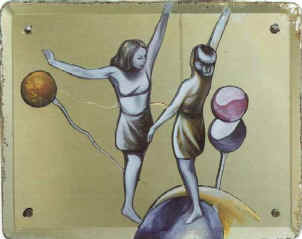 |
Egyéni kiállítása:
1998 Bartók 32 Galéria. Budapest
Csoportos kiállítások:
1991 Rajzolás emlékezetből. diploma kiállítás, Magyar Képzőművészeti Főiskola,
Budapest
Folyamat Galéria, Budapest
Oszcilláció. VI. Bástya, Komárom, Műcsarnok, Budapest
1992 Körtér. Budapest Kiállító, Budapest
Tondo. Józsefvárosi Galéria, Budapest Folyamat Galéria, Budapest
1993 A hiszékenység vámszedői. MTV: Ifjúsági Sáv (videofilm, 25 perc, Haász
Katalinnal)
Áthatás. Lengyel Kultúra Háza, Budapest
Folyamat Galéria, Budapest
1994 Diploma kiállítás. Magyar Képzőművészeti Főiskola, Budapest (intermédia
szak)
Folyamat Galéria, Budapest
1996 Gallery by Slides. Bartók 32 Galéria, Budapest1998 Inter/Média/Art. Ernst Múzeum,
Budapest |
Publikáció a
kiállításról:
Peternák Miklós: NŐ-ÖN, Szabó Ágnes kiállítása. Balkon, 1998/1-2. |
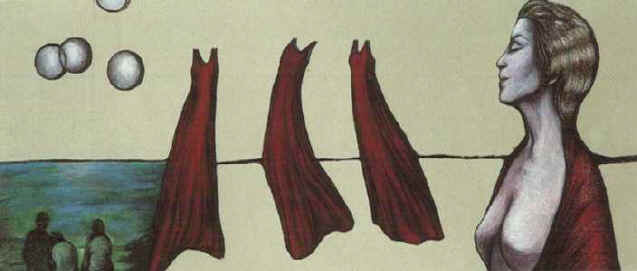 |
fotók: Sulyok Miklós
Támogatók: Liga, Budapest XI. kerületi
Kulturális Alap
 
|